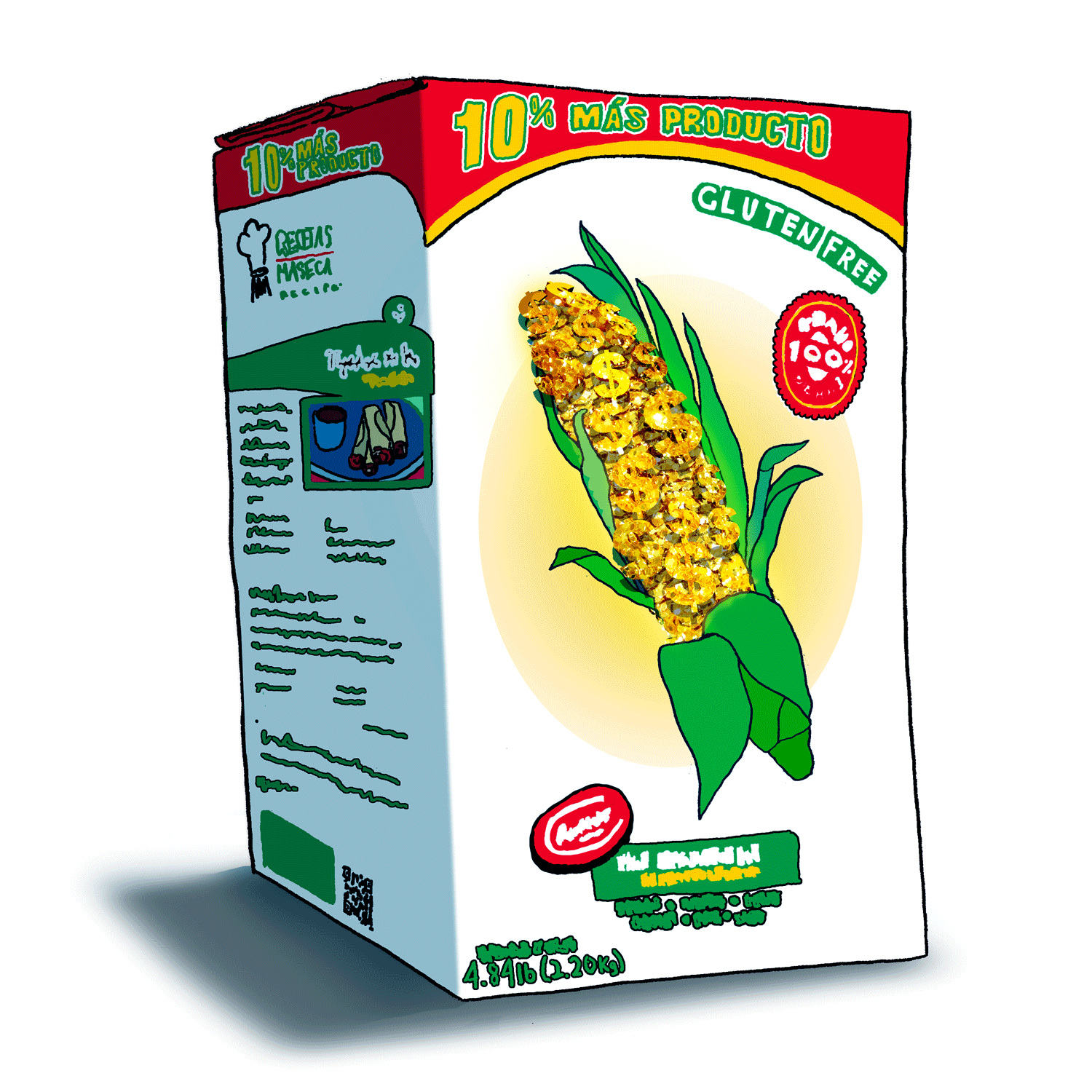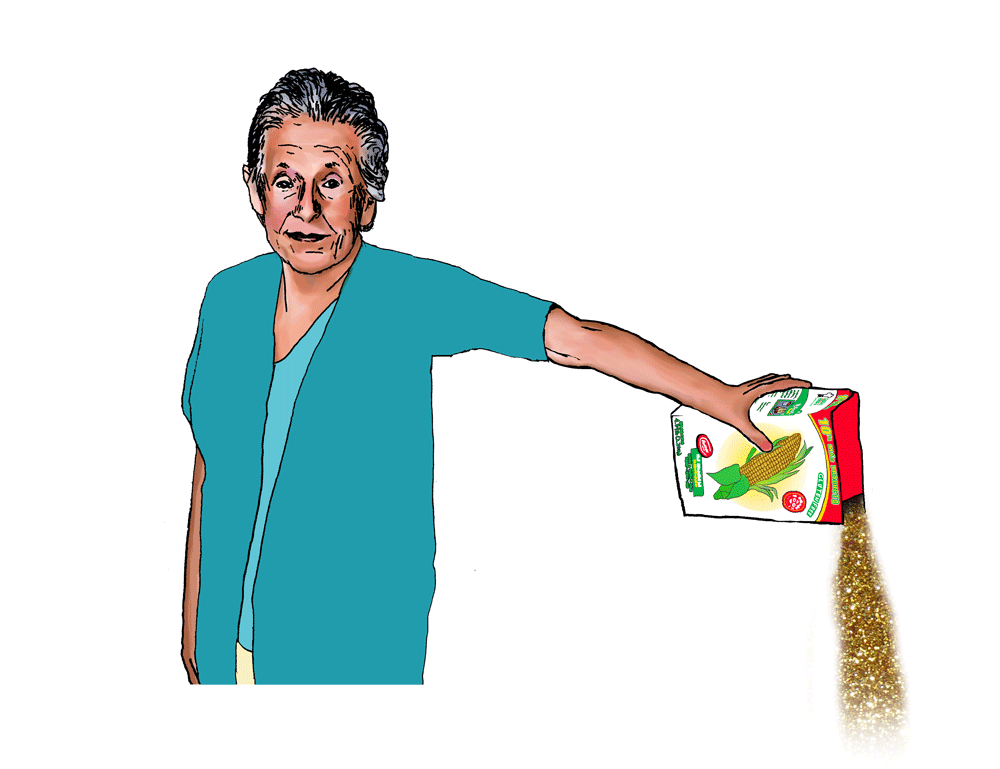
The rise of industrial instant corn flour, masa harina, represents not only a gastronomic loss (the stuff tastes lousy), but a death blow to Mexico’s corn heritage.
Several years ago, while researching a story about gourmet tacos, I called Diana Kennedy at her home in Michoacán in Mexico. Kennedy, who is 95, is often described as the Julia Child of Mexico, owing to the fact that in her six decades living there, she has written a series of cookbooks that demystified the nation’s complex and highly regional cuisine for an international audience. When it comes to temperament, though, the two women share little in common. While Child was bubbly and solicitous, Kennedy has a thornier nature—which came into full bloom when we began to discuss corn tortillas. Her position was that the vast majority of them, in Mexico as well as the United States, are inedible: “To me, a taco with a tortilla made from that powdered thing…well, there’s no point in having a taco.”
“That powdered thing” she was referring to is Maseca, the world’s best-selling brand of masa harina: corn dough dehydrated to a flour, which can be reconstituted with hot water for fresh-pressed tortillas. This is the method, and the very brand, recommended for making corn tortillas “from scratch” by virtually every English-language cooking reference that I’m aware of, from The New York Times to Serious Eats. Rick Bayless, one of this country’s foremost authorities on Mexican food, calls for Maseca in his cookbooks. Even Saveur, a magazine known for cooking coverage that verges on culinary ethnography, has a video on its website of the chef Jose Garces whipping up tortillas from Maseca, which, to hear Kennedy tell it, is like a highly trained barista demonstrating how to stir Folgers into boiling water.
Paging through The Cuisines of Mexico—Kennedy’s iconic 1972 field guide for Mexican foodways—I learned that making corn tortillas from scratch does not begin by buying a bag of Maseca on the internet, after all. The first step is growing the corn, a traditional practice for rural Mexican families who wish to produce enough grain for their own use. The kernels are dried and stored, and then every time tortillas are made, steeped in a mixture of water and pickling lime overnight to remove their fibrous hulls (a process called nixtamalization). Next, the softened corn must be drained and ground by hand, between stones, into masa, then pressed into tortillas and cooked on a griddle. Start to finish, the process takes as long as 20 hours; because masa ferments quickly, it must be repeated daily and has been in homes across Central America since pre-Columbian times. “The cooking of corn in Mexico, with all its elaborations and ramifications, is, and always has been, within the realm of the highest culinary art, beyond that of any other country,” Kennedy writes. Masa is hard. Masa makes the egg sushi from Jiro Dreams of Sushi look like a parlor game.
Enter Maseca, in the glossy white bag emblazoned with an ear of corn, rendered in cheerful tones of yellow and green. In the United States, Maseca can be found in Mexican mercados and increasingly also supermarkets, WalMarts, and of course on Amazon, where a two-kilo bag costs $5. Dump the sandy powder in a bowl, add hot water, roll it into balls, and press: ersatz corn tortillas in under 15 minutes. I consider myself a tortilla novice but have by this point eaten quite a variety of them, from the ethereal versions made daily from heirloom Mexican corn at the restaurant Cosme in New York City to the gummy, acrid Mission brand ones sold at Safeway. My verdict: To someone who wasn’t raised on real-deal tortillas from fresh masa, Maseca tortillas may be short on flavor, but they are hardly repugnant. I wondered what, exactly, this lady’s problem was.
Initially, I put Kennedy’s anti-Maseca fervor down to simple perfectionism, of the kind I have so often encountered on the message boards of Chowhound or Serious Eats—where culinary sticklers lurk, like trolls under a bridge, ready to shame those who make even the smallest sacrifice to quality in the name of ease. Years later, though, I think that I finally understand the true nature of her beef with Maseca. I believe now that she was expressing a fundamental distaste at a very dirty truth about the world’s largest producer of dehydrated corn flour: Maseca’s control of the tortilla industry in both Mexico and the United States—at least partially the result of a conspiracy between government and industry—is to blame for putting a country’s ancient corn heritage in jeopardy and defiling its most iconic food staple.
When I ask the writer and food historian Gustavo Arellano about Maseca’s history in Mexico, he gives it to me straight: “Maseca is like Bisquick for tortillas, only Bisquick didn’t get help from the the Mexican government to dominate the flour industry.”
Corn tortillas were for thousands of years the primary subsistence food of Central America. No food in the American diet approaches their cultural dominance. We’ve already discussed the grueling work of producing masa by hand; as Arellano recounts in his 2012 book Taco USA, once Mexico began to industrialize in the late 19th century, towns built centralized corn mills where women could bring the nixtamal produced from their own milpa, or vegetable garden, to eliminate the back-breaking work of grinding it at home. In the early 20th century, mechanical tortilla presses removed even more labor from the equation. Masa harina, the instant corn flour, was first invented in the United States around the same time, but despite the convenience it promised, it failed to catch on in Mexico until pressure, and price supports, from the Mexican government shoehorned it into daily life.
In 1949, a Mexican businessman named Roberto Gonzalez Barrera founded the company that today is known as Gruma, a multinational tortilla powerhouse that began by manufacturing masa harina from commodity corn under the name Maseca. The company pushed its corn flour to tortilla factories across Mexico, and in 1977 expanded to the United States, acquiring small operations and converting them to the use of Maseca. Gruma bought the Mission and Guerrero brands of packaged tortillas, which it still owns to this day. (Gruma’s U.S. revenues are now over $2 billion annually, meaning its products account for more than half of a U.S. tortilla market that the research firm IBISworld estimates at $4 billion.)
In Mexico, in the beginning, interest in Maseca was tepid at best, due to its bland taste and grainy texture—when compared with real masa made from local heirloom corn. “It was seen as a vastly inferior product,” Anthony De Palma, who served as a foreign correspondent in Mexico City for The New York Times, tells me. “These were the equivalent of TV dinners.” Rumors circulated that Maseca tortillas were so bland because the company cut its corn flour with paper pulp. Sales in Mexico limped along for decades.
But as De Palma reported in a front-page story for the Times in 1996, Gonzalez happened to be a personal friend of Carlos Salinas de Gortari, who became president of Mexico in 1988. At that time, the government bought corn from Mexican farmers at a premium and sold it to tortilla factories at a discount, as a means to support farmers while maintaining affordable pricing for the staple food. In 1990, Salinas’s government froze the amount of corn given to tortilla shops and demanded that all growth in the market be filled by masa harina. At the time, the Times reported, the only producer of masa harina besides the Mexican government was Gruma. “What Gonzalez did to get subsidies from the Mexican government allowed him to build his empire,” De Palma tells me. “He could not have done it without that government support.” In 1988, Gruma had 11 facilities producing corn flour. Today, the company has more than 40.
Gonzalez did everything he could to capitalize on the windfall from the Salinas government. Gruma offered free equipment to tortilla factories to make the switch to Maseca. Meanwhile, the Mexican government punished tortillerias that refused to convert from fresh corn dough to corn flour by giving them the worst grain—putting hundreds out of business. Today Maseca controls three quarters of the corn flour market in Mexico, and a quarter of the country’s entire tortilla production.
Maseca is produced from commodity corn in factories around the globe, according to a secretive process that is said to replace traditional nixtamalization with an enzymatic reaction. “I’ve done as much research as I could possibly do to find out how it’s made, and boy are they tight-lipped,” Bayless tells me. Sources say that the corn’s natural oils are stripped out to promote shelf stability, and the dough is blasted at high heat for quick and thorough drying. While tortillas are still made from fresh masa in some rural parts of Mexico, such as Oaxaca and the Yucatan, and at high-end restaurants in the capital, for most Mexicans, those made with masa harina are the only option. The rise of industrial corn flour represents not only a gastronomic loss, but an agricultural one, too: With many fewer Mexicans growing heirloom corn for personal use, dozens of ancient corn varieties are under threat.
So if you’re not keen on participating in what Gustavo Arellano calls the “Maseca cartel,” where to go from here? All but the staunchest slow foodies—I’m looking at you, Mark Bittman—admit that making your own masa at home is a nonstarter. Kennedy dismissed the idea of American home cooks trying the process themselves and suggested that we might get masa from a local Mexican restaurant. But on second thought, many of those places use Maseca, too, or add preservatives, which puts them on about the same level as Mission and Guerrero tortillas. So it’s probably better to avoid eating tortillas in America altogether.
Arellano is more optimistic. He says lots of tortillerias and mercados where he lives, in Southern California, undertake the masa process from scratch, and that your absolute best option is to find one near you. Pick up a stack of fresh tortillas, use what you can within a day or two, and freeze the rest. “The best thing is when you get them so fresh, the plastic bag they’re in steams up and their texture is almost creamy,” he says. Although nothing beats a freshly made tortilla, as long as they’re packaged in an airtight container, tortillas stand up surprisingly well to freezing.
Luckily, in addition to those generations-old tortillerias and taquerias that have kept on trucking, a fresh masa movement is under way in the United States, echoing the artisanal bread movement that began here years ago. Susana Trilling, who has run a well-known cooking school in the Oaxaca region of Mexico since the early 1990s, tells me that in recent years, she’s seen a steady uptick in American chefs and entrepreneurs coming to her school to learn to make fresh masa.
“Maseca is like Bisquick for tortillas, only Bisquick didn’t get help from the the Mexican government to dominate the flour industry.”
A key player in the masa revival is a company called Masienda, which in 2014 began importing heirloom corn to the United States from thousands of smallholder farmers in Mexico who have struggled to compete with subsidized corn from the United States that began flooding into Mexico in the mid-1990s as a result of the NAFTA treaty. Corn grown in the United States is almost exclusively high-yield commodity grain and lacks the rich flavor of the 59 distinct varieties grown on family plots in Mexico. There are now dozens of restaurants that buy Masienda’s corn to make true from-scratch tortillas and tamales.
In the past year, the company has also begun producing its own preservative-free, heirloom corn tortillas for home use—which are sold in the refrigerated section at Whole Foods in a growing number of regions, including the Northeast and Southern California. Supermarket tortillas are traditionally a pretty sad affair, owing both to the flavorless commodity grain used to produce them and the preservatives that lend them a sour flavor. Masienda’s are a different story—the texture is chewier than a fresh tortilla, but when compared to other packaged options, I found them to have the same noticeably purer, richer, toasty corn flavor found in restaurants producing their own masa. (PSA: Tortillas must be reheated properly to get the best results. Bayless, who was an early investor in Masienda, has two methods for bringing premade tortillas back to life: Either brush them with oil and heat them in a cast-iron pan until warm and pliant, or place a stack in a plastic bag with a dampened paper towel, microwave for 1 minute, and let rest for 2 minutes.)
The best part about buying Masienda tortillas may not be the taste, but the politics: By helping to preserve heirloom corn varieties and remind people of what a great tortilla really tastes like, they offer a small step toward reversing the changes set in motion by Gruma decades ago.


